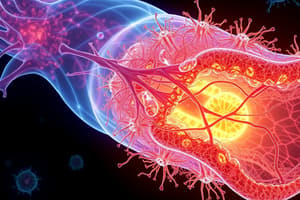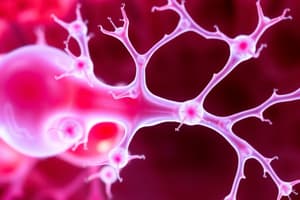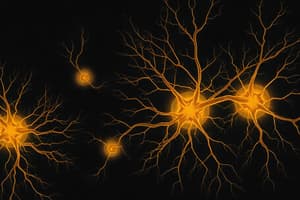Podcast
Questions and Answers
Neural crest cells are characterized by their ability to:
Neural crest cells are characterized by their ability to:
- Migrate extensively throughout the embryo and differentiate into diverse cell types. (correct)
- Undergo rapid mitosis to form the initial layers of the ectoderm.
- Primarily contribute to the formation of the neural tube and central nervous system.
- Remain in their original embryonic location and differentiate into a single cell type.
Which set of developmental regulatory genes is primarily associated with the migration and differentiation of neural crest cells?
Which set of developmental regulatory genes is primarily associated with the migration and differentiation of neural crest cells?
- eve, ftz, prd
- MyoD, Pax6, Wnt
- Hox, snail, Dlx (correct)
- bicoid, nanos, hunchback
Neural crest cells contribute to the formation of a wide variety of tissues and organs. Which of the following is NOT primarily derived from neural crest cells?
Neural crest cells contribute to the formation of a wide variety of tissues and organs. Which of the following is NOT primarily derived from neural crest cells?
- Craniofacial cartilage and bone
- Melanocytes (pigment cells)
- Peripheral nervous system
- Liver parenchyma (correct)
Darwin observed beak variations in birds and noted their early developmental origin. Schneider and Helms' experiments using quail and duck embryos demonstrated that:
Darwin observed beak variations in birds and noted their early developmental origin. Schneider and Helms' experiments using quail and duck embryos demonstrated that:
In Schneider and Helms' experiment, transplanting duck neural crest cells into a quail embryo resulted in a quail with a beak that was:
In Schneider and Helms' experiment, transplanting duck neural crest cells into a quail embryo resulted in a quail with a beak that was:
The 'domestication syndrome' in mammals is hypothesized to be linked to changes in neural crest cell development primarily due to selection for:
The 'domestication syndrome' in mammals is hypothesized to be linked to changes in neural crest cell development primarily due to selection for:
According to the neural crest hypothesis for domestication syndrome, traits like floppy ears and shorter snouts are considered:
According to the neural crest hypothesis for domestication syndrome, traits like floppy ears and shorter snouts are considered:
The hypothalamic-pituitary-adrenal (HPA) axis, relevant to the domestication syndrome, is primarily involved in regulating:
The hypothalamic-pituitary-adrenal (HPA) axis, relevant to the domestication syndrome, is primarily involved in regulating:
The neural crest hypothesis proposes that selection for calm behavior in domestication leads to a reduction in HPA axis activity, which is achieved, in part, by:
The neural crest hypothesis proposes that selection for calm behavior in domestication leads to a reduction in HPA axis activity, which is achieved, in part, by:
Evidence suggesting that neural crest cells are not a vertebrate innovation comes from the study of:
Evidence suggesting that neural crest cells are not a vertebrate innovation comes from the study of:
The presence of neural crest-like cells in lancelets and ascidians suggests that neural crest cells in vertebrates likely evolved through:
The presence of neural crest-like cells in lancelets and ascidians suggests that neural crest cells in vertebrates likely evolved through:
Evo-devo studies emphasize that significant phenotypic changes can arise from:
Evo-devo studies emphasize that significant phenotypic changes can arise from:
Homeotic genes and regulatory enhancers are central to evo-devo because they:
Homeotic genes and regulatory enhancers are central to evo-devo because they:
Considering the role of neural crest cells in craniofacial development, a mutation affecting neural crest cell migration timing would most likely result in:
Considering the role of neural crest cells in craniofacial development, a mutation affecting neural crest cell migration timing would most likely result in:
In the context of evolution, changes in developmental timing or spatial positioning controlled by evo-devo mechanisms:
In the context of evolution, changes in developmental timing or spatial positioning controlled by evo-devo mechanisms:
If a drug inhibited the migration of neural crest cells during embryonic development, which of the following would be the most likely consequence?
If a drug inhibited the migration of neural crest cells during embryonic development, which of the following would be the most likely consequence?
The experiment involving silver foxes, selected for tameness, provides support for the neural crest hypothesis because domesticated foxes exhibit:
The experiment involving silver foxes, selected for tameness, provides support for the neural crest hypothesis because domesticated foxes exhibit:
Considering the evolutionary history of neural crest cells, which statement is most accurate?
Considering the evolutionary history of neural crest cells, which statement is most accurate?
The 'neural crest' hypothesis for domestication syndrome suggests that the suite of domestication traits is primarily a consequence of:
The 'neural crest' hypothesis for domestication syndrome suggests that the suite of domestication traits is primarily a consequence of:
Which of the following best describes the relationship between neural crest cells and the traits observed in the domestication syndrome?
Which of the following best describes the relationship between neural crest cells and the traits observed in the domestication syndrome?
Flashcards
Neural Crest Cells
Neural Crest Cells
Embryonic stem cells in vertebrates that migrate and differentiate into various tissues and organs.
Hox, snail, and Dlx
Hox, snail, and Dlx
Developmental regulatory genes that control the migration and differentiation of neural crest cells.
Schneider and Helms Experiment
Schneider and Helms Experiment
Experiment involving ducks and quails; transplanting embryonic neural crest cells alters beak shape.
Domestication Syndrome
Domestication Syndrome
Signup and view all the flashcards
Neural Crest Hypothesis
Neural Crest Hypothesis
Signup and view all the flashcards
Hypothalamic–pituitary–adrenal (HPA) axis
Hypothalamic–pituitary–adrenal (HPA) axis
Signup and view all the flashcards
Lancelets (Amphioxus)
Lancelets (Amphioxus)
Signup and view all the flashcards
Study Notes
- Neural crest cells are embryonic stem cells in vertebrates that differentiate into various cell types.
- These cells originate near the neural tube and migrate to different locations, guided by regulatory genes like Hox, snail, and Dlx.
- Neural crest cells contribute to the formation of blood vessels, the heart, the brain, the nervous system, the thymus, adipose tissue, the craniofacial region of the skull, and teeth.
Neural Crest Cells and Beak Development
- Darwin observed that beak proportions in birds are constant and determined early in development.
- Beak shape significantly impacts fitness through foraging, aggression, and mate choice.
- Transplanting embryonic neural crest cells between ducks and quail alters beak development, showing the critical role of neural crest cells in beak formation.
- Transplanting duck neural crest cells into quail embryos resulted in quails developing duck-like beaks.
- Transplanting quail neural crest cells into duck embryos resulted in ducks developing quail-like beaks.
Neural Crest Hypothesis and the Domestication Syndrome
- The domestication syndrome includes traits like changes in facial morphology, floppy ears, curly tails, altered coloration, decreased stress hormone levels, increased neurotransmitters, frequent estrus cycles, and reduced tooth/brain size.
- Selection for calm behavior is considered a key factor in animal domestication.
- The neural crest hypothesis suggests that selection for calm behavior reduces HPA axis activity, influencing stress responses.
- Reduced HPA activity is achieved by decreasing the number and migration speed of neural crest cells.
- Traits in the domestication syndrome are proposed to be byproducts of reduced neural crest cell migration due to selection for reduced HPA activity.
- Reduced numbers or migration of neural crest cells leads to reduction in cartilage (floppy ears and curly tails), reduction in bone (shorter snout length), and slower melanocyte migration (mottled fur patterns).
Evolution of Neural Crest Cells
- Neural crest cells were initially believed to be unique to vertebrates.
- Lancelets possess cells similar to neural crest cells, which migrate over the neural tube and are controlled by homeotic genes.
- Similar cells have also been found in ascidians.
- Evolutionary biologists hypothesize that neural crest cells evolved from ancestral cells similar to those in ascidians and lancelets, potentially through gene duplications.
Evo-Devo Summary
- Evo-devo focuses on the interplay of evolution and organismal development.
- Homeotic genes and regulatory enhancers play a crucial role in development.
- Small changes in timing or location during development can cause large phenotypic effects.
- These changes can be under strong selection and involved in the formation of new species.
Studying That Suits You
Use AI to generate personalized quizzes and flashcards to suit your learning preferences.




